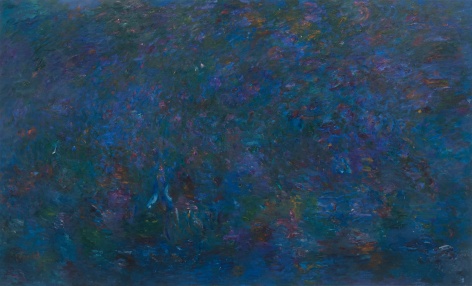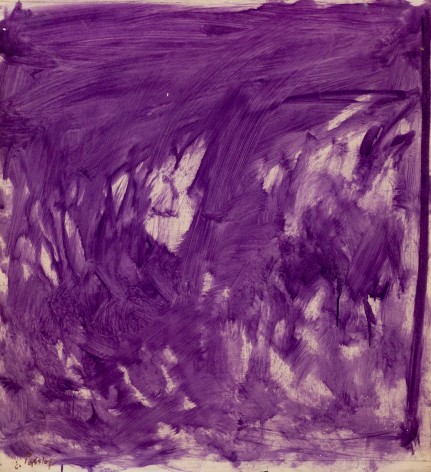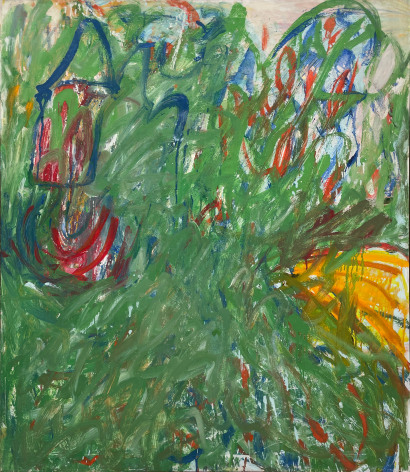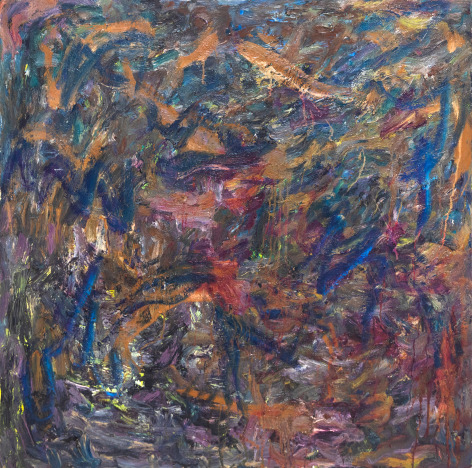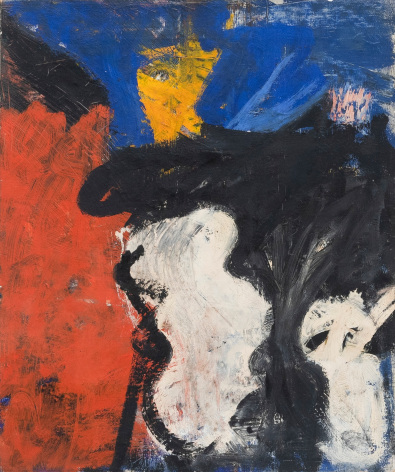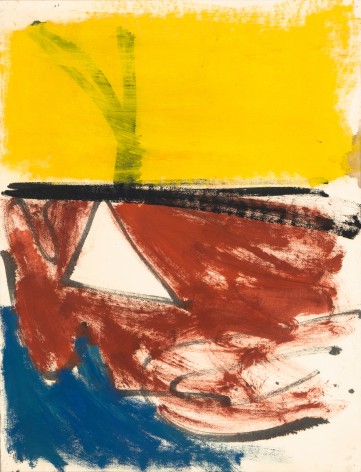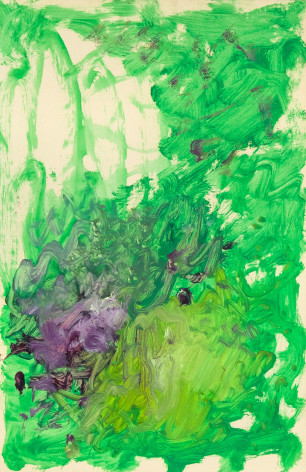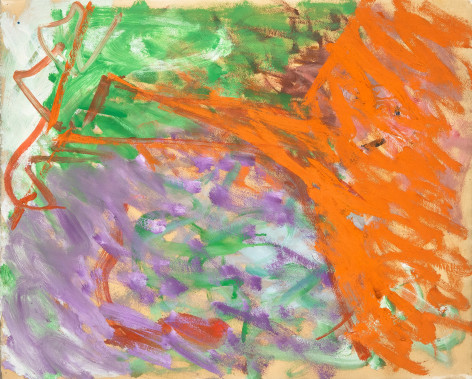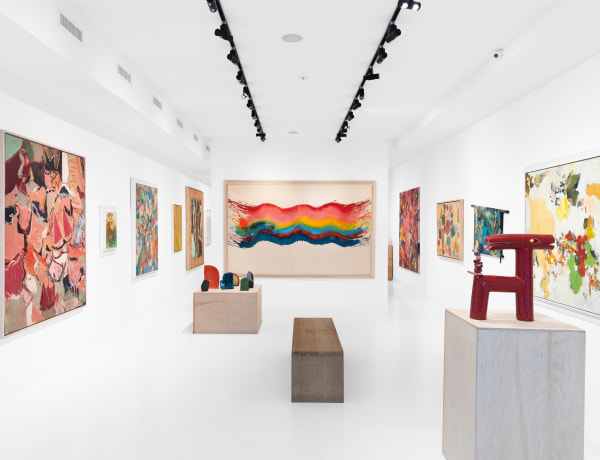
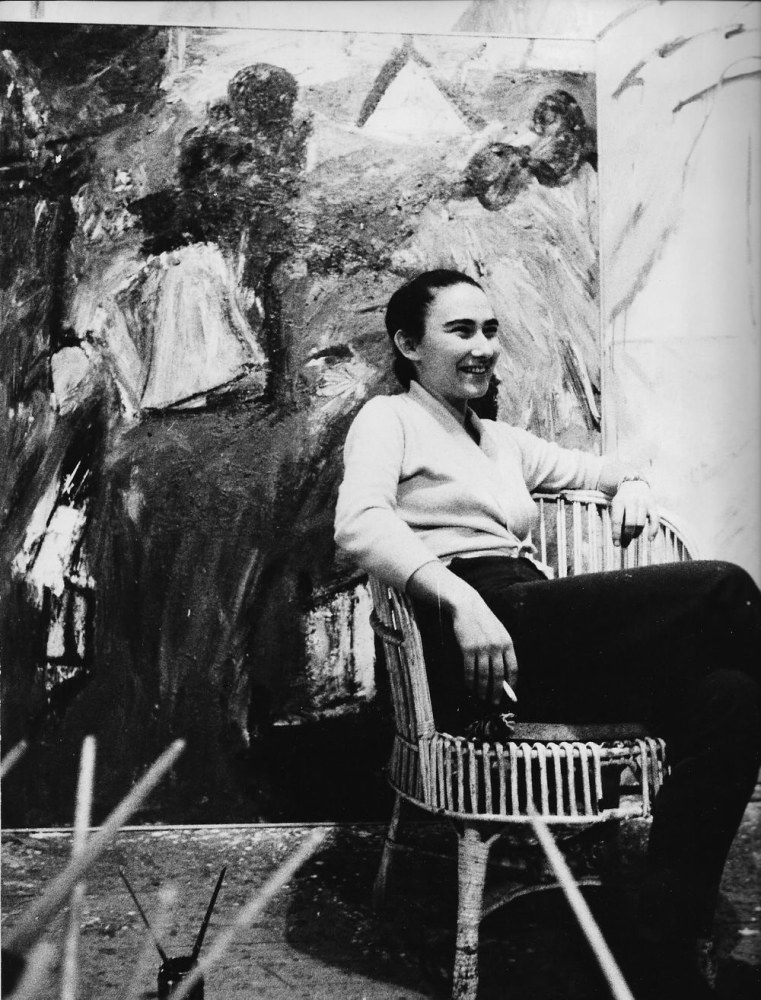
Pat Passlof in her studio on Tenth Street, c. 1958. Photo by Jesse Fernandez.
B. GEORGIA, 1928
D. NEW YORK CITY, 2011
Pat Passlof was an abstract painter of the New York School whose tireless exploration of color and form gave her work a distinct voice. Having grown up in New York, in 1948, Passlof travelled to Asheville, North Carolina to study at the famed Black Mountain College, where she took classes with Willem de Kooning. This summer proved pivotal for her trajectory as a painter; she continued to study with de Kooning privately after returning to New York, eventually leaving the city again to earn a BFA at Cranbrook Academy of Art in 1951. Back in New York in the 1950s, she became a fixture in the downtown arts scene, attending meetings at The Club (eventually organizing “The Wednesday Night Club”), showing at the March Gallery on 10th Street, and marrying fellow painter Milton Resnick.
Passlof’s early work built on her art education. She utilized biomorphic forms like those in the contemporary work of Arshile Gorky and de Kooning and was influenced by existentialist ideology which informed Abstract Expressionism. However, Passlof was always individualistic and her work was constantly varied in terms of touch, form, and palette. She was never content to repeat herself.
By the 1960s her palette began to lighten. She used repeated patterns and marks across the canvas to create dynamic rhythms. She drew upon experiences and memories, as noted by titles referring to people and places. However, she never believed in narrative in painting, even when in later years, her work became peopled by centaurs, nymphs, and horses.
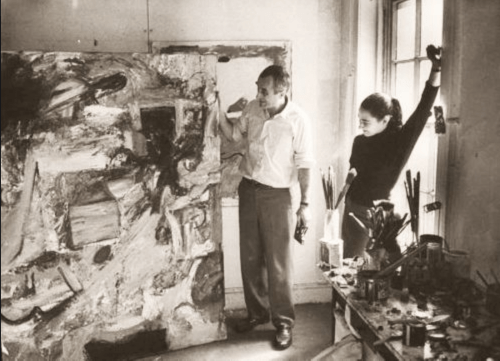
Her work often suggested abstracted landscapes, like the later work of Claude Monet, although Passlof often worked in a vertical format. She lived and worked in the Lower East Side, in a former synagogue. Her husband, Resnick, had his own synagogue building as a live/work space. In addition, they spent time in the Shawangunk Mountain area of upstate New York, and the space and air of the mountain ridge influenced her painting.
Passlof was a beloved and dedicated professor who taught at Richmond College, CUNY, from 1972 to 1983; and the College of Staten Island, CUNY from 1983 until 2010 (the year before her death.) The 2018 publication To Whom the Shoe Fits, is a compilation of letters she wrote to her undergraduate students over the years.
Passlof was the subject of a solo exhibition at the famed Green Gallery, New York in 1961. In the 1960s and 70s she also showed at the Globe Gallery, the Feiner Gallery, and the Landmark Gallery. Beginning in the 1990s, she exhibited regularly with Elizabeth Harris Gallery. A retrospective of her work was held at the Black Mountain College Museum, Asheville, NC, in 2011. Her work was included in the 2017 exhibition at the Museum of Modern Art, Making Space: Women Artists and Postwar Abstraction. Passlof was the subject of a retrospective exhibition curated by Karen Wilkin at the Milton Resnick and Pat Passlof Foundation in 2020. Her work can also be found in the collections of the Milwaukee Museum of Art; the Corcoran Collection; and the Black Mountain College Art Museum, among others. Her work was recently acquired by the Whitney Museum, the Museum of Modern Art, and Crystal Bridges Museum.
Non-Objectified presents a dynamic group of works by female artists operating under the umbrella of abstraction. The show’s title is a play on the term ‘non-objective’ painting, coined by by Alexander Rodchenko in 1918. This movement was centered in Europe and created in reaction to centuries of figurative representation, as practiced and espoused in the academies. Non-Objectified is a riff on Rodchenko’s term, a double entendre exploring female artists’ resistance to the objectification of bodies. The show takes the form of a dialogue between works by a cross-generational, international group of artists selected for their varying approaches to abstraction, each variation invoking or involving the body in subtle ways.
The Milton Resnick and Pat Passlof Foundation is pleased to present Pat Passlof: Authors & Poets, 1999-2000. The exhibition is on view May 9 - July 20, 2024.
The paintings came first—the titles came after.
We are pleased to announce that Pat Passlof’s Ile Fra (1960) has been acquired by Crystal Bridges Museum of American Art as part of the museum’s permanent collection.
"A highlight was the celebration of some of the female (abstract) greats—Joan Mitchell (Helly Nahmad), Helen Frankthaller (Berggruen Gallery) and Pat Passlof (Eric Firestone Gallery) and Vivian Springford (Almine Rech)."
The buzz of contemporary art at Frieze London might take centerstage in October, when the U.K. city’s art galleries bring out their finest works, but the fair’s classic arm Frieze Masters is where the hidden gems are.
Featuring more than 120 galleries, Frieze Masters is celebrating its 10th anniversary this year as well as its recent debut in Seoul. The fair’s main section has around 97 galleries from around the world presenting works spanning six millennia of history (in organizers’s words), from ancient artifacts to Modern art, as well as previously unrecognized talent.
The main exhibitors are joined by 28 galleries in the Spotlight section dedicated to women artists curated by Camille Morineau, co-founder and research director of Archives of Women Artists, Research, and Exhibitions (AWARE), and her team. And Luke Syson, the director of the Fitzwilliam Museum in Cambridge, is the curator of the Stand Out section, highlighting 10 galleries under the theme of global exchange.
Our highlights of the art historical (re)discoveries in this year’s Frieze Masters center around female artists from a diverse cultural and geographical background. Many of them have lived through turmoil and upheavals of the 20th century, or having struggled to find a foothold in a male-dominated art world. Eventually they succeeded in creating these rich bodies of work that helped to push the boundary
Pat Passlof
ERIC FIRESTONE GALLERY | NEW YORK
Pat Passlof (1928–2011) was an important figure in the development of the New York School of Abstract Expressionism. She was there from the beginning and, indeed, one of its incubators. In 1948, she studied with Willem de Kooning at Black Mountain College in North Carolina, the place to be if one wanted to become an avant-garde artist. That was also the year Arshile Gorky committed suicide; his Surrealized take on abstraction, along with that of his friend de Kooning, remained an influence on Passlof. But as “Memories of Tenth Street: Paintings by Pat Passlof, 1948–63”—a presentation at Eric Firestone Gallery that featured a thoughtful selection of works the artist created in Manhattan’s East Village at the titular address—made abidingly clear, Passlof’s painterly innovations eschewed the aggressive grandiosity of her mentors for something more lyrical, intimate, and inviting. Even though Untitled, 1950, with its thin black lines and planar, smeary sections of pale gold and white, seems indebted to Gorky’s paintings, and Theater, 1957, with its turbulent facture and thick encrustations of dirty violet, red, and fawn, carry a generous dose of de Kooning’s method, Passlof truly astonishes in such delicate, subtle works as Miss Julia, 1961, with its quivering, luminescent surface awash in sundry pinks, yellows, browns, and blues radiating from a loosened grid. In this “pure” abstraction, Passlof achieves aesthetic independence. “The being of the work of art yields itself only through its sensuous presence,” French phenomenologist Mikel Dufrenne wrote, “which allows [us] to apprehend it as an aesthetic object.” Outgrowing the lessons of her confreres, Passlof comes into her own with extraordinary sensuousness. It seems safe to say that without Black Mountain College there would have been little or no future for avant-garde art. (And Europe, where it had developed, had become a war-torn ruin by 1948.) It is important to emphasize the year Passlof began studying with de Kooning: The New World was the place to revivify the sensation of the new, which had become timeworn and stale in the Old World. It also seems safe to say that Passlof’s transcendental aesthetic, and its subliminal affinity with American Luminism, surpasses the more earthbound—dare one say heavy-handed?—work of de Kooning and Gorky.
Passlof was instrumental in the restoration of vanguard culture in more ways than one. As the gallery’s press release tells us: “In 1949, Passlof helped renovate the Eighth Street loft, which was the first location of ‘The (Artists’) Club,’ attending every talk and panel. Noticing that many of her peers rarely spoke when they came to the Club, she decided to organize an alternative ‘Wednesday Night Club,’ envisioning it as a kind of ‘junior club.’ The Wednesday evening sessions quickly became popular, leading the old guard to squelch it for fear of competition.” Clearly, Passlof was in the thick of it, fearlessly holding her own despite the condescending dismissal of her paintings as retardataire—“more ‘impressionistic’ than ‘abstract,’” as Donald Judd once wrote, along with his trivialization of her color as “somewhat sweet,” another coyly misogynist characterization. Certainly Passlof’s paintings don’t climb the wall like desperate, erect penises the way Judd’s sculptures do, the boxes that constitute them a record of so many feckless orgasms. If the Abstract Expressionists were masturbators of gesture, then Judd was a masturbator of geometry. These were so-called big men: They always seemed to live in fear of the “junior club,” i.e., smart, pioneering women.
— Donald Kuspit
In October, the The Milton Resnick and Pat Passlof Foundation opened its third exhibition, “Pat Passlof: The Brush Is the Finger of the Brain,” a survey of Passlof’s paintings curated by Karen Wilkin. Comprising twenty-six works on three floors, the show efficiently and effectively samples Passlof’s art from 1949 to 2011. Although she showed regularly in New York galleries (in recent decades, primarily at Elizabeth Harris), Passlof often garnered more attention for her active art-scene presence and her associations with other artists than for her own work. Happily, this seems to be changing. In 2017 the Museum of Modern Art in New York acquired its first work by Passlof, a ca. 1950 oil on paper that the museum has already shown twice, in “Making Space: Women Artists and Postwar Abstraction” in 2017 and in the current reinstallation of the collection.
Whitechapel Gallery presents a major exhibition of 150 paintings from an overlooked generation of 81 international women artists.

